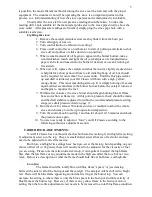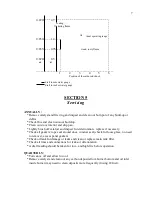
WEEKLY:
*The de-coking rod must be operated at least once per week to eliminate carbon
deposits that build up where oil enters the burner bottom:
1. Remove front burner access cover.
2. Slightly back brass packing nut off (counterclockwise) to release de-coking
rod. (Be careful as packing nut may be hot. A glove may be necessary.)
3. Slowly draw rod out until it stops while rotating 360 degrees several
times. A small pair of pliers or vise grips may be helpful. This rod has a
scraper internally that scrapes away carbon from inside the line.
4. While still rotating, push the rod back in until it stops and tighten the packing
nut snugly.
5. Replace access panel.
*Note:
If flame is burning lower than expected, you probably have carbon build-up in
the line or burner bottom near fuel inlet.
SECTION 6
Trouble-shooting guide
CONDITION:
1. Oil present in burner with the carburetor in “off” position.
2. No oil in burner bottom after carburetor is turned on.
3. Flame smoky when lit.
4. Flame smoky when burning low.
5. Flame smoky when burning high.
6. Flame goes out on low.
7. Flame goes out in high winds.
8. Burner goes out and will not re-light.
9. Flame is noisy (buzzing or roaring) or separating from the burner on high-fire.
10. Flame size seems lower than normal while on high.
11. Dirty or sooty glass.
12. Oil smell in room.
POTENTIAL PROBLEM:
1. -Carburetor had been left on previously without the burner being lit.
2. -Shut-off lever tripped off, and needs to be pressed to start.
-One of the valves in the oil supply line shut off.
-No oil in the tank.
-Carburetor control plate stuck (tap on carburetor lightly).
-Air lock in supply line.
-Plugged filter (either primary filter or carburetor filter).
-Condensed water in supply line that has frozen in cold weather.
8





























